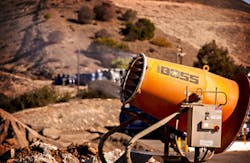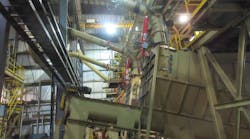A west-coast recycler of asphalt and concrete from large demolition and road projects employs an atomized mist dust suppression system to control air quality in and around its Chula Vista plant.
Operating one of the largest pavement salvage and reclaimed asphalt pavement production facilities in the region, Reclaimed Aggregates Inc. (RAI) occupies five acres in Southern California. By upgrading its dust suppression from a sprinkler system, operators report a substantial air quality improvement in the material receiving area.
RAI was formed as a subsidiary of Pavement Recycling Systems (PRS) in 2005, with its first two locations in Colton and Lancaster. In 2009, the company’s Chula Vista facility was added and acts as its largest processing location, receiving and processing concrete and asphalt recovered from multiple road and construction demolition projects.
Dozens of dump trucks per day deliver recovered pavement from projects all over the San Diego area to the Chula Vista site. Material is offloaded onto a 200 ft by 200 ft dry-earth receiving area and immediately moved by front loader to the crusher or into storage piles.
"The offloading process creates a tremendous amount of dust, and that was causing issues for our neighbors who run large vehicle salvage lots," says Facilities Manager Robert Erautt. "At first, we tried to reduce the amount of dust with a sprinkler system. It just saturated the material, creating a lot of mud, but dust still remained an issue."
Specified suppression
Company officials reviewed their options and discovered the DustBoss series of suppression equipment from Peoria, Illinois-based Dust Control Technology (DCT). They chose the DB-45 based on its range, which is well suited to the size of the area requiring dust management. The unit can throw its atomized plume 150 feet to deliver effective dust control over a 12,000 sq ft area. When equipped with optional 359-degree oscillation, the unit can cover as much as 74,000 sq ft from a single location.
Mist is created by a stainless steel manifold with 18 brass atomizing nozzles delivering 80+ PSI of pressure, propelling millions of droplets with an 18,000 CFM, 15 hp industrial fan, to deliver a dense curtain of water droplets atomized to a 50-200 micron size range, which creates the greatest attraction to most dust particles.
"Size range is critical to avoid the ‘slipstream’ effect that large droplets from sprinklers have on airborne dust particles," explains DCT President Laura Stiverson. "In most applications, fugitive particles are generally around 50-100 microns in size, but water droplets from a sprinkler are much larger, often 2000 to 6000 microns. The velocity of the large sprinkler droplet affects the airflow, and when an airborne particle approaches it, the flow often deflects the particle without a collision between dust and droplet."
In contrast, the atomized mist system creates droplets much closer in size to the dust particles, which encourages the necessary contact to bring dust particles to the ground. The sheer number of these miniscule droplets also increases the surface area available to contact airborne particles, without over-saturating the debris. While large sprinklers can apply 500 gpm or more, the DB-45 puts out just 11.3 gpm at 100 psi inlet pressure, helping RAI prevent mud and minimize runoff.
"The DustBoss made an immediate impact," Erautt continues. "On hot dry days — which we get a lot of around here — a little breeze can carry dust a long way. We just turn on the atomizer and you can see the mist pull the dust out of the air. The unit is on a metal carriage, so we can adjust its position if the wind changes, but generally it stays in one place."
"We leave the machine running most of the day if it isn’t raining," Erautt adds. "We haven’t had a single call from our neighbors about dust from the day we added it."
Prior to material recycling, California roads were constructed with aggregate and sand pulled from local quarries. To replace these roads, thousands of tons of existing asphalt, concrete and base were removed and transported to landfills, while virgin material was trucked in. Reclaimed Aggregates has made it possible to minimize the use of new materials by recycling road and construction debris into its Class II base CMB (crushed miscellaneous base), meeting CalTrans specifications. RAI primarily produces a Recycled Class II base, as well as various products and materials for use in pavement preservation using 100 percent recycled asphalt.
Recycling in place
In addition to cold milling, pavement preservation and soil stabilization, cold in-place recycling (CIR or CIPR) is available. The process involves a "train" of several different machines, which together handle the milling of existing asphalt pavement. It is then removed from the roadbed and added to a crusher with its own integrated dust suppression, which reduces the material to a 1-inch minus aggregate. The aggregate is transferred to a machine that mixes the cold milled material with asphalt-based emulsified recycling agents in an engineered mix design. The cold recycled asphalt is installed, compacted to specific depths and then overlaid with a thin section of virgin asphalt. Sometimes a slurry is installed over the recycled asphalt as a preservation tool.
"A road project can involve thousands of truck loads carrying asphalt out and bringing material in, causing a lot of dust and traffic," Erautt points out. "The CIR process only requires the engineered emulsion to be shipped in, reducing truck traffic 40:1 and lowering the carbon footprint of most projects by about 70 percent to 80 percent. In addition, the work is done faster, the cost of the process plummets and the finished product is just as good."
This "engineered approach to sustainable solutions" is part of a push for greener, more environmentally sound construction methods.
"Our goal is to reduce as much material going into landfills as possible," Erautt concludes. "Recycling material is just good business, but it shouldn’t come at the expense of air quality. A clean and efficient operation that includes dust control keeps the community and clients happy. It’s good for everyone in the end."
For questions or further details about Reclaimed Aggregates, please contact Robert Erautt at [email protected].
Dust Control Technology is a global leader in dust and odor control solutions for ports and shipping, slag handling, material recycling, coal, petcoke and demolition. DCT equipment carries the industry’s longest warranty, and can be purchased outright or rented from an extensive fleet of dust suppression equipment.


